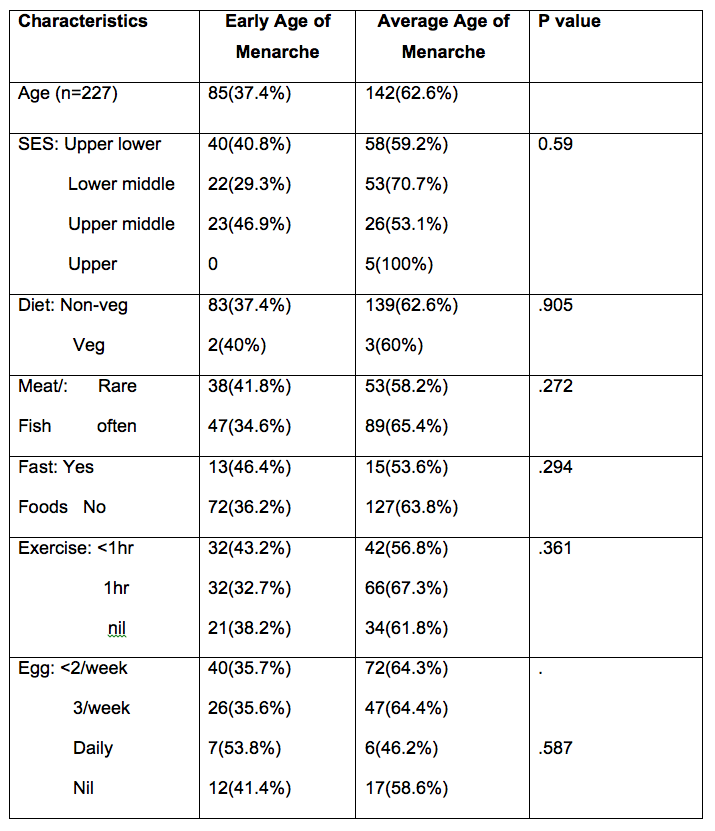Introduction
The word puberty is derived from the Latin word “pubertus” which means “age of manhood.” It refers to the biological developments that lead to physical maturity and capacity for reproduction. There has been a secular (time-related) trend towards an earlier onset of menarche with a decline of two to three months per decade [Wyshak, Tehrani] An Indian study has shown that in the last three decades, the age at menarche has been lowered at an average rate of about six months per decade and reflects upon the improved socio-economic, nutritional, and general conditions in India. [Bagga]
The health implications of age of onset of menarche include metabolic syndrome, cardiovascular disease, cancers, polycystic ovarian syndrome, amenorrhea, dysmenorrhea, anemia, and infertility. Girls with early menarche exhibited elevated blood pressure and glucose intolerance compared with later maturing girls, independent of body composition. [Remsburg]
An earlier ICMR study (1972) found the mean age to be 13 years and 9 months. Agarwal, et al. (1992) have mentioned the age of menarche to be 12.6 years and the study by Bagga and Kulkarni (2000) found the mean age at menarche to be 12.5 years. Indian data suggests that in the past, the age for onset of menarche was 12-14 years however there has been a steady decline in the age of onset of menarche up to nine to 10 years. [Bagga]
Studies show that higher intake of proteins and fats in the diet, higher body fat percentage (BMI), anthropometry, reduced physical activity, socioeconomic status, and body mass index may have a contributory role in an early onset of menarche.[GokhaleKhatoon, Malina, Simmons, Banerjee]
This study was undertaken with the research question, “Do children with higher growth parameters attain menarche earlier?”
Review of Literature
Objectives
- To assess the prevalence of early menarche in girls attending a rural school;
- To assess the influence of physical growth indicated by height, weight, mid-arm circumference and chest circumference, waist and hip circumference on age of attaining menarche in rural school girls.
Materials and methods
Study Design: This is a cross-sectional study on rural school going girls.
Study population: Girls in the age group of nine to 15 years studying in rural schools.
Approval for study: The study had been done only after receiving approval from the institutional review board and ethics committee. The school principals had been approached for permission to do the study and written informed consent had been obtained from the parents and the girls.
Study Duration: Two months
Study Period: June15 to August 15, 2017.
Study definitions
- Puberty
The landmarks of the pubertal events in girls are the onset of puberty, peak height velocity, and menarche. The onset of puberty is marked by the -------- development of breast tissue, while PHV is the highest velocity that is observed during the pubertal growth spurt. Menarche or the onset of menstruation is a late event in puberty and usually occurs six months after PHV is achieved. [Karapanou] - Onset of Menarche
In this study, we take two groups: Early onset of menarche in the age group nine to 11 years and average onset of menarche in the age group >12 years. - Parameters of Physical Growth
- Height in cm
- Weight in kg
- Mid-arm circumference
- Chest circumference
- Waist circumference
- Hip circumference
- Diet: vegetarian / non-vegetarian.
- Exercise: Physical activity type → walking/ games / athletics
Time <One hour/day / One to two hours / day / >Three hours / day
Inclusion Criteria
All girl children in the age group of nine to 15 years studying in the rural school were enrolled to the study if they fulfilled the selection criteria and their parents had given the consent.
Exclusion Criteria
Children who were absent on the day the data was collected and who had given back the consent form.
Instruments
-
Case Study Form
-
Kuppusamy’s scale for Socio economic status
Sampling
Children had been enrolled from selected schools in this rural area by consecutive sampling. Every girl child in the selected classes who had fulfilled the selection criteria and whose parents had given informed consent had been recruited to the study till the sample size was achieved.
Sample size
Sample size was calculated using nMaster Sample Size computer software. [N Master] In the reference study by Bagga and Kulkarni done in Pune, the mean menarcheal age was found to be 12.5 years. Of the 366 girls majority (68 percent) achieved menarche between the ages of 12 years and 14 years. The early onset of menarche was recorded in 18 percent and late onset in 13.6 percent of the girls. [Bagga]
Using the mean values from the above study which reported early menarche occurred in 18 percent of girls in the study sample of 366 girls. The Sample size was 227 girls for a single group for a confidence interval of 95 percent and estimated precision of five percent. The required sample size will be 227 girls in the age group nine to 15 years studying in rural schools. The formula is given below.
Sample size was calculated using the formula given below.
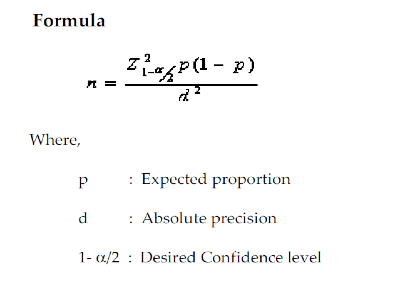
The sample size for a 95% confidence interval and precision of 5% required will be 227 rural girls in the age of 9 to 15 years.
Study Procedure
The study had been submitted to the Institutional Review Board for scientific review and to the Ethics Committee for ethical review. After permissions were obtained from the school principal, the parents had been approached to obtain written informed consent. All girls were children in the age group nine to 15 years, whose parents had given written informed consent and had been consecutively enrolled to the study if they fulfill selection criteria.
The demographic data, relevant history, and anthropometric measurements had been entered into the Case Study Form. The children had been divided into two groups: early and average menarche. The demographic variables and risk factors had been compared in the early and average menarche groups using Chi square test for categorical variables and student t-test for continuous variables using SPSS software.
Statistical Analysis
Continuous variables will be described using mean and standard deviation (SD), or median and interquartile range. Categorical variables will be described with frequencies and confidence intervals. The risk factors in early and late menarche will be compared for the early and late menarcheal group using Chi square test.
Ethical considerations
The study will be conducted after we receive permission from the school authorities and written informed consent from parents and also from the girls participating in the study. A handout will be given to all children detailing the principles of good menstrual hygiene. The investigator will take a class for the children and explain the basic physiology and the good practices of menstrual hygiene.
Observations and Results
Of the 227 girls, majority (62.6p.c) achieved menarche between the ages 12-15 years and early onset of menarche in age nine to 11 years was recorded in 37 percent of girls.
Table1: Physical Growth and Menarcheal Age
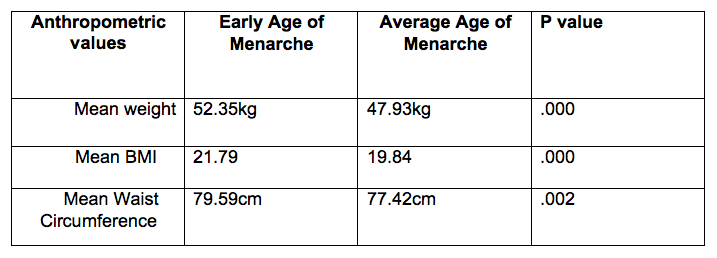
Table 1: Anthropometric values such as mean weight, mean waist circumference and BMI had significant impact on attaining early menarche. The girls who achieved menarche earlier (between 9-11 years) showed the maximum mean body weight (52.35kg) than other group, being 4.42kg more than average group who showed (47.93kg).
Table 2: Physical Growth and Menarcheal Age
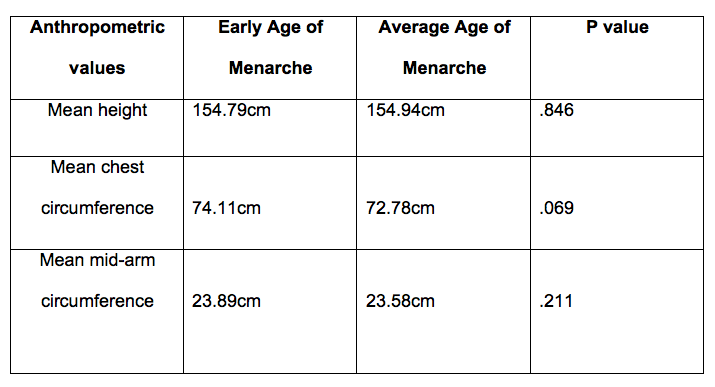
Table 2: Mean height had no impact on attaining early menarche except for mean chest circumference and mean mid arm circumference the difference between early and average menarcheal group were statistically significant.
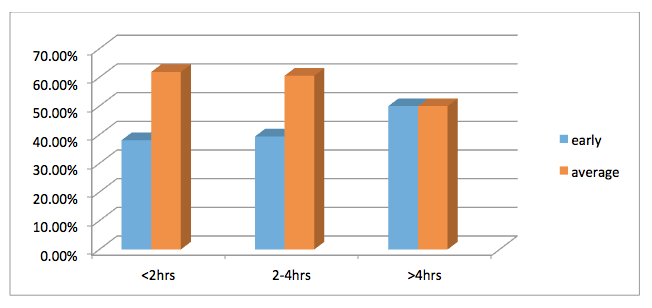
TV Viewing and Age at Menarche
From the above figure there is secular trend in attaining early menarche for those girls who viewed TV more time than the average group. This would be due to sedentary lifestyle which leads to early Menarcheal age. The p value was found to be .054.
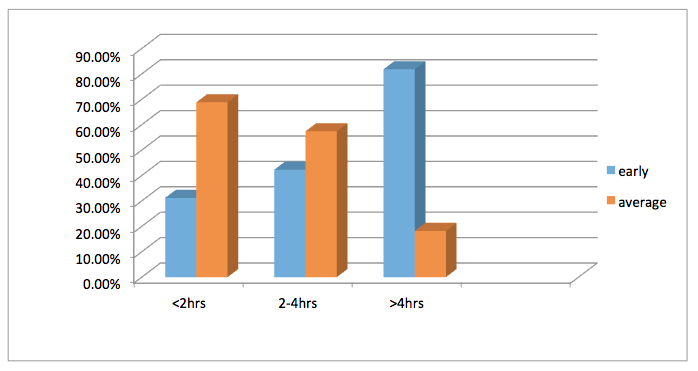
From the above figure, there is again secular trend in attaining early menarche for those girls who played more computer and mobile games than average group. This would be a changing sedentary lifestyle that these girls attained early menarche. The p value was found to be .009.
Baseline Characteristic of Study Group
Discussion
Conclusions
The prevalence of early menarche was found to be 37 percent.
The physical growth factors such weight , waist circumference, and BMI had significant impact on attaining early menarche.
Summary
Implications
This will be a valuable experience for me to develop skills in interviewing, history-taking, and clinical examination of a child. It is important to use the principles of research methodology and good practices in research and I hope to use these principles in this study.
Works Cited
1. Wyshak G, Frisch RE. Evidence for a seculartrend in age of menarche. N Engl J Med 1982;306: 1033-1035.
2. Remsberg KE, Demerath EW, Schubert CM et al. Early menarche and the development of cardiovascular disease risk factors in adolescent girls: the Fels Longitudinal Study. The Journal of Clinical Endocrinology & Metabolism 2005; 90(5): 2718-24.
3. Sample size measured using nMaster Sample Size Calculation software produced by Department of Biostatistics, Christian Medical College, Vellore 632 004. Tamil Nadu. India.
4. Bagga A, Kulkarni S. Age at menarche and secular trend in Maharashtrian (Indian) girls.2000. Acta BiologicaSzegediensis. Volume 44(1-4):53-57.
5. Indian Council of Medical Research (ICMR) (1972) Growth and physical of development of Indian infants and children. Technical Report Ser18, New Delhi.
6. Agarwal DK, Agarwal KN. Physical and sexualgrowth pattern of affluent Indian children from5-18 years of age. Indian Pediatr 1992; 29: 940-949.
7. Gokhale D. Factors Influencing Age at Menarche: An Indian Scenario. Ind. J. Youth Adol. Health 2015; 2(3)
8. Khatoon TK, Verma AK, ReemaKumari, Rupani R, Singh M, Rizvi. Age at menarche and affecting Bio-Social factors among the girls of Lucknow, Uttar Pradesh. J Indian Acad Forensic Med.2011, Vol. 33. , No. 3. 221-23. ISSN 0971-0973.
9. Malina RN. Exercise as an influence upon growth. 1979 Clin Paediatrics8:16-26.
10. Simmons K, Greulich WW (1943) Menarcheal age and the height, weightand skeletal age of girls age 7 to 17 years. J Paediatrics 22:518-548.
11. Banerjee I, Chakraborty S, Bhattacharya NG, BandopadhyayS, Saiyed HN, Mukherjee D. A cohort study of correlationbetween body mass index and age at menarche in healthyBengali girls. Journal of the Indian Medical Association2007; 105(2): 75-8.
12. Gururaj, Maheshwaran. Kuppuswamy's Socio-Economic Status Scale - A Revision of Income Parameter For 2014. International Journal of Recent Trends in Science And Technology, ISSN 2277-2812 E-ISSN 2249-8109, Volume 11, Issue 1, 2014 pp 01-02.



